The components of the aijk tensor are nonzero for 20 acentric symmetry groups. If the electrodes of the crystal are opened, the photovoltaic current Ji generates photovoltaic voltages

where σ t and σ f, respectively, are the dark and photoconductivity, l is the distance between the electrodes. The generated photovoltage is of the order of 103—105 V, thus exceeding the value of the band gap E g by two to four orders of magnitude.
In accordance with (1) and the symmetry of the point group of the crystal, expressions can be written for the photovoltaic current Ji. Comparison of the experimental angular dependence of J i (β) with (1) makes it possible to determine the photovoltaic tensor a ijk or photovoltaic coefficient

a* is the light absorption coefficient.
As shown by Belinicher [4], depending on the shape of the optical indicatrix and the direction of propagation of plane polarized light in the crystal, there may be directions for which the photovoltaic current (1) is spatially oscillating. In this case:
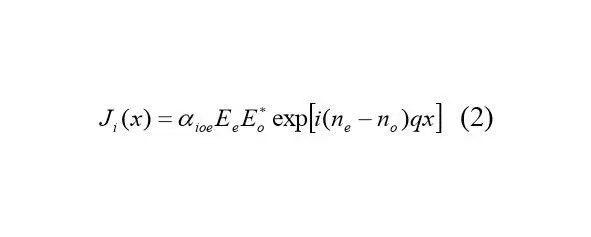
where n e, n 0 are the refractive indices of ordinary and extraordinary rays, E e and E 0* are the projections of the polarization vector of light on the optical axes of the crystal,
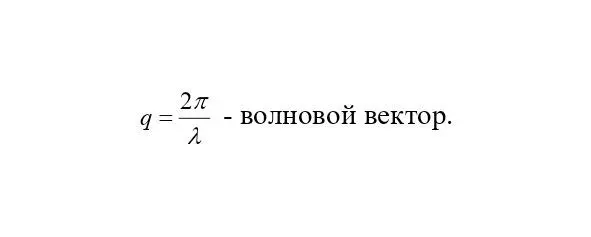
In this case, the photovoltaic current (2) oscillates in the crystal with a period of

As indicated in [4] and as can be seen from (2), a spatially oscillating photovoltaic current (SWEAT) can be experimentally observed under conditions of strong light absorption.

where α* is the absorption coefficient.
1. SPATIALLY OSCILLATING PHOTOVOLTAIC CURRENT IN SbSi FERROELECTRIC
In this paper, a spatially oscillating photovoltaic current (POFT) in the direction [100] in the SbSI ferroelectric is detected and investigated when illuminated with polarized light in the direction [010].
Antimony sulfoiodide (SbSI) belongs to the class of chalcogenides of metals of the fifth group A VB VIC II, where A-Sb; Bi; B-S, Se, Te; C-CL, Br, I. SbSI and SbSI xBr 1-x crystals are biaxial, have a large double refraction, below temperature. Curie T c=22 0C SbSI crystals belong to the mm2 class and have rhombic symmetry. During the phase transformation, the center of symmetry disappears, therefore, SbSI crystals become ferroelectrics below the transition point.
The phase transition at 22 0C was registered for the first time by Fatuzzo [5] with a change in the temperature dependence of the dielectric constant. Crystals have pronounced semiconductor properties, their photovoltaic properties are well studied [1].
Measurements were carried out for SbSI single crystals in the ferroelectric phase at a temperature of T = 133 K. The crystal was illuminated by plane polarized light using a xenon lamp and a ZMR monochromator. The stationary photovoltaic current J was measured by the method previously described [1]. In accordance with the SbSI symmetry (point group mm 2), when measuring J z (z is the direction of spontaneous polarization) and illuminating the crystal in the x and y directions, POFT does not occur. The expression for the photovoltaic current Jz when illuminated in the x and y directions, respectively, has the form:
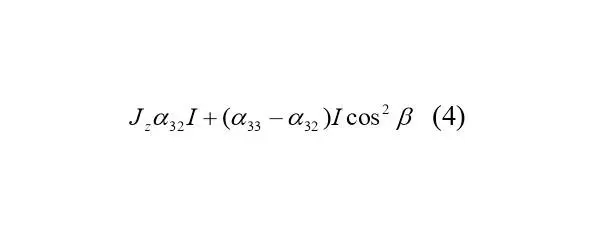
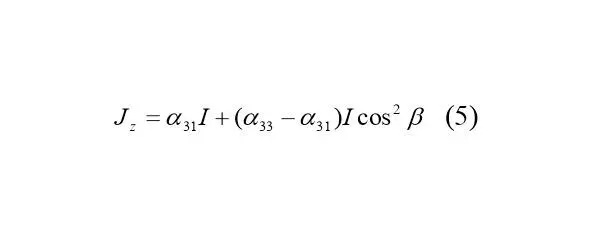
where I is the light intensity, β is the angle between the plane of polarization of light and the z axis. In Fig.1, curve 1 represents the experimental angular dependence of J z (β) for λ=600 nm when illuminated along [100]. From the comparison of the experimental angular dependences of J z (β) with (4) and (5), the numerical values of αιjκ or photovoltaic coefficients were estimated

Taking into account pleochroism and anisotropy of light reflection in SbSI [6], the following values were obtained:
K 314*10 —8; K 323*10 —8; K 33 (2—3) *10 —8A*cm* (W) -1. Thus, in SbSI, the photovoltaic coefficients K 31, K 32, K 33 are more than an order of magnitude higher than the corresponding coefficients in LiNbO3: Fe.

Fig.1. Dependence of the photovoltaic current Jz (1) at l = 600 nm and J x (2) at l = 460 on the orientation of the plane of polarization of light in SbSI.
According to (2), for SbSI, the photovoltaic current components are spatially oscillating. However, when the crystal is illuminated in the region of strong absorption in the direction of the x or y axes and when condition (3) is met, currents flow along the surfaces (100) and (010), respectively.
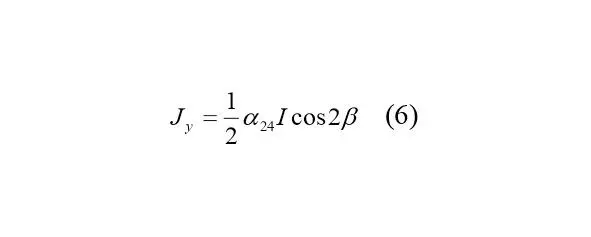

where β is the angle between the plane of polarization of light and the z axis. According to [1,7] for SbSI, the strong absorption condition (3) should be fulfilled already at λ470 nm. To observe the POFT under conditions of strong absorption, silver electrodes in the form of bands parallel to the axis of spontaneous polarization z were sprayed onto the face of the cinacoid (010). Using these electrodes, when the crystal was illuminated in the direction [010] by polarized light with λ=460 nm, the current J x curve 2 was measured and the current J z was measured in the long-wavelength region (λ=600nm, curve 1).The angular dependence of the measured current satisfies (5), while the Oh current in this region cannot be observed at all due to violation of condition (3) and spatial oscillation. Figure 2 shows the spectral J z (curve 1), J x (curve 2), attributed to the unit of incident energy, as well as the spectral dependence

constructed taking into account the dispersion of n0, pe and the absorption coefficient α* in the [010] direction.
Читать дальше

























